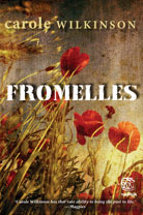Fromelles: Australia's bloodiest day at war by Carole Wilkinson

Black Dog Books, 2011. ISBN 978 174203176 7.
(Ages: 10-16) Non Fiction. Highly recommended. At 11 am on July 19,
1916, the bloodiest battle involving Australian troops began. By the
end of the 24 hours, more than 5000 Australian soldiers were killed,
wounded or taken prisoner. The statistics tell a horrifying story, but
Wilkinson's precise prose fills out the numbers to create a memorable
plea for the recognition that these men did not give up their lives in
vain. Many were buried in mass graves and it is fitting that nearly 100
years after the event some of these graves have been found, the bodies
examined and given names, and reburied with full military honours.
Wilkinson outlines the reason the troops were there at that particular
time. Many were untried and usually the new troops were sent initially
to somewhere safer, but this was not to be. The orders were given,
despite many changes even hours before the battle, bombs had blasted
the German trenches for seven hours and then the troops were told to
advance. But the plan did not work. the Germans were waiting and many
allied troops were simply mown down as they tried to cross no man's
land. The Germans had watched the preparations for days from their
higher vantage point, and knew that the feint to make it appear that
there were more troops than was really the case, was not true. At the
end of the day, killed and wounded alike were stuck in this area, with
little hope of retrieval. Wilkinson details the reasons for this
mammoth failure, lack of communication, lack of knowledge of the German
entrenchment, untried troops, lack of leadership and so on.
But it is what happens next that has captured the imagination of many.
A Melbourne school teacher, Lambis Englezos, was so engrossed with the
whole story that he researched it further, and was convinced after
studying photographs before ad after the battle, documents in England,
Australia and Germany, that there were soldiers unaccounted for. He
focussed his attentions on Pheasant Wood, a place behind German lines,
where there was clearly a piece of ground that had been turned over.
His tenacity saw the exhumation and identification of these soldiers,
and they were buried in a new cemetery at Fromelles.
An amazing story brilliantly recreated by Wilkinson, she ends the story
telling us that this appalling battle is still not recognised in its
own right, but as part of the Battle of the Somme, for which it was
supposed to provide some respite. As with all of black dog books'
series, The Drum, this account is littered with maps,
statistics and
photographs, many of which are refreshingly unpublished, and with
linking fictional letters from serving soldiers. This fascinating
account will thrill its readers.
Fran Knight